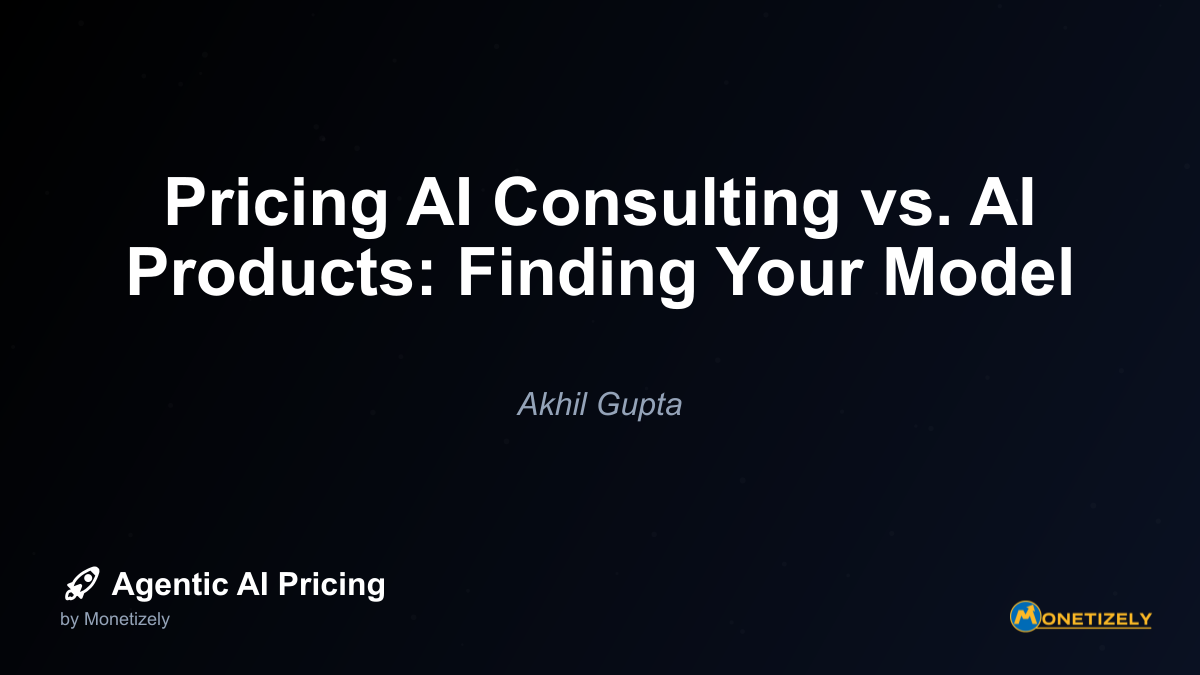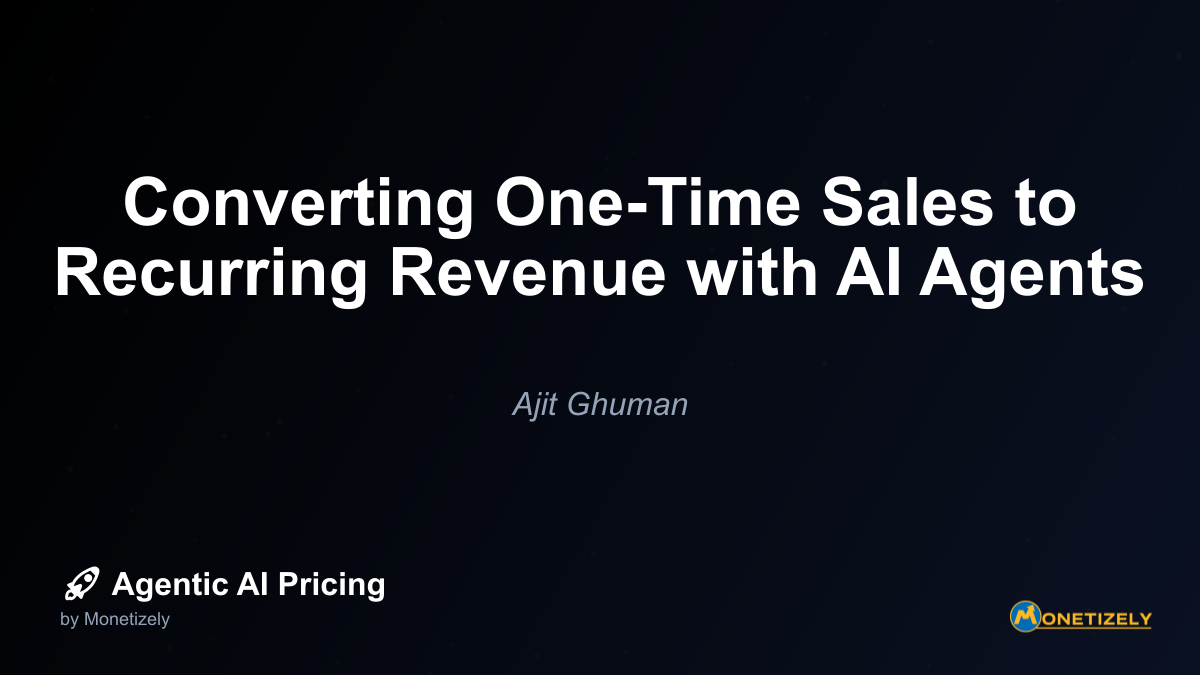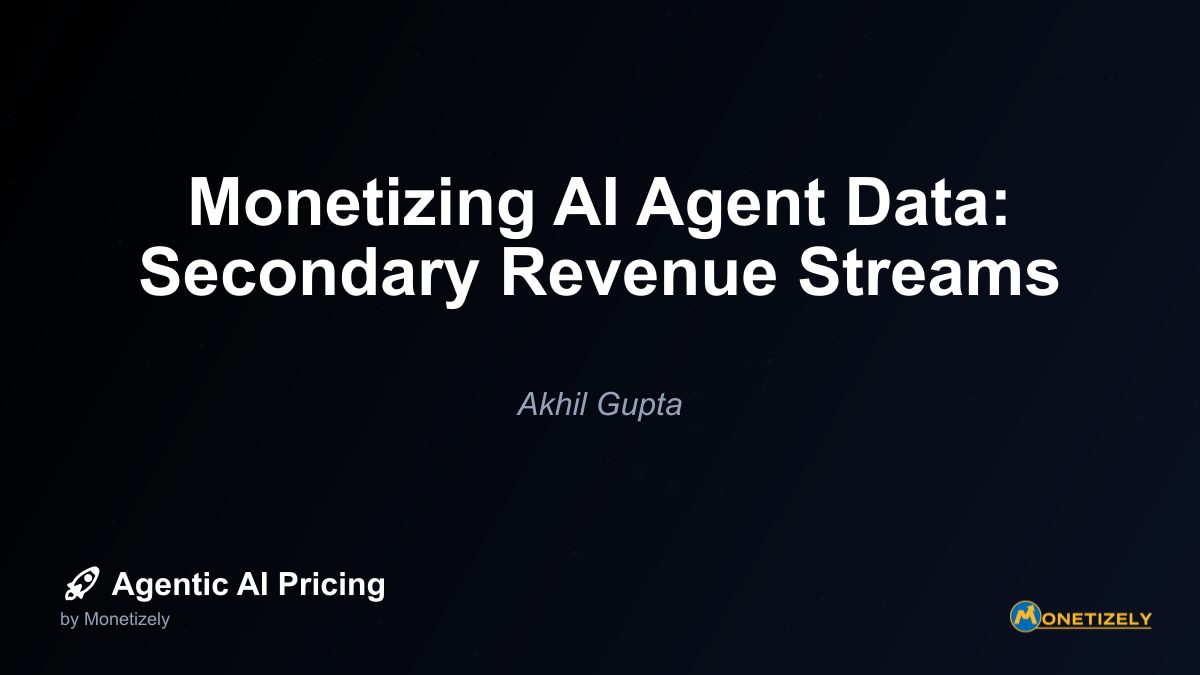· Akhil Gupta · Business Models · 13 min read
Pricing AI Consulting vs. AI Products: Finding Your Model
AI and SaaS Pricing Masterclass
Learn the art of strategic pricing directly from industry experts. Our comprehensive course provides frameworks and methodologies for optimizing your pricing strategy in the evolving AI landscape. Earn a professional certification that can be imported directly to your LinkedIn profile.

In the rapidly evolving landscape of artificial intelligence, businesses face a critical strategic decision: should they position their AI offerings as consulting services, productized solutions, or some hybrid combination? This choice fundamentally shapes everything from revenue models and scalability to client relationships and market positioning.
While both approaches leverage AI capabilities to create value, they represent distinctly different business models with unique advantages, challenges, and pricing considerations. Understanding these differences is essential for executives and pricing strategists seeking to maximize both competitive advantage and profitability in the AI economy.
The Fundamental Distinction: Services vs. Products
At their core, AI consulting services and AI products represent two fundamentally different approaches to delivering AI capabilities to clients and customers.
AI Consulting Services: The Human-Centered Approach
AI consulting services are primarily human-delivered engagements that leverage specialized expertise to solve complex, often unique client problems. These services typically involve:
- Custom analysis and solution design based on specific client needs
- Direct collaboration between consultants and client teams
- Bespoke implementation and integration with existing systems
- Knowledge transfer and capability building
- Ongoing strategic guidance and support
The value proposition centers on expertise, customization, and relationship-based problem-solving. Pricing models for AI consulting services have evolved significantly in recent years, with a strong trend toward value-based and usage-based approaches that better align with AI-enhanced efficiencies and outcomes.
According to recent market research, value-based pricing has become increasingly dominant in the AI consulting space. This model prices services based on the specific value and outcomes delivered to clients rather than hourly or fixed fees. This approach enables consultants to secure larger projects (often $10,000+) by demonstrating enhanced service quality and efficiency from AI integration.
AI Products: The Scalable Solution Approach
In contrast, AI products are standardized, scalable solutions designed to address common problems across multiple customers with minimal customization. Key characteristics include:
- Predefined features and capabilities
- Self-service or minimally assisted implementation
- Standardized integration options
- Product documentation and support resources
- Regular updates and improvements for all customers
The value proposition focuses on accessibility, consistency, and economies of scale. AI product pricing has undergone significant transformation, with traditional seat-based pricing declining in favor of more flexible approaches.
Usage-based models that price based on actual consumption of AI resources (such as API calls or data processed) have gained popularity for their flexibility, though they offer less predictability. Hybrid models that combine seat-based subscriptions with usage or outcome-based fees have grown substantially, increasing from 27% to 41% adoption among AI companies according to recent industry data.
Pricing Models Compared: Services vs. Products
The pricing approaches for AI consulting services versus AI products reflect their fundamental differences in delivery, scalability, and value creation.
AI Consulting Service Pricing Models
Hourly or Daily Rates: Traditional time-based billing ranging from $100 to $450 per hour depending on expertise and engagement depth. While still common, this model is increasingly giving way to more outcome-oriented approaches.
Project-Based Fees: Fixed prices for defined deliverables, typically ranging from $10,000 to $500,000+ depending on complexity, customization requirements, and integration needs.
Value-Based Pricing: Fees tied directly to measurable business benefits such as cost savings, revenue increases, or efficiency improvements. This approach often calculates fees as a percentage (10-40%) of the client’s gains.
Retainer Models: Ongoing advisory relationships with monthly fees ranging from $5,000 to $70,000 annually for continued support, maintenance, and optimization.
Performance-Based Pricing: Compensation structures with base fees plus bonuses tied to achieving specific metrics or outcomes, sharing both risk and reward with clients.
AI Product Pricing Models
Subscription-Based Pricing: Fixed monthly or annual fees for access to the AI product, often tiered based on features, usage limits, or user counts. Basic AI automation packages might start at $99/month, while advanced enterprise platforms can cost thousands per month.
Usage-Based Pricing: Fees determined by actual consumption of AI resources, such as API calls, compute time, or data processed. For example, OpenAI’s GPT-4 Turbo ranges from $0.003 to $0.012 per 1,000 tokens.
Tiered Pricing: Structured packages with increasing capabilities and limits at different price points, allowing customers to select the tier that best fits their needs and budget.
Freemium Models: Basic functionality offered free of charge, with premium features or expanded usage requiring payment. This approach is common for AI products seeking rapid adoption.
Outcome-Based Pricing: Fees linked to specific business results achieved through the AI product, such as conversion rates, time savings, or error reduction.
Key Differences in Pricing Approaches
The pricing structures for AI consulting services and products differ in several important dimensions:
| Aspect | AI Consulting Services | AI Products |
|---|---|---|
| Pricing basis | Expertise, time, and outcomes | Features, usage, and access |
| Customization premium | High - reflects unique solutions | Low - standardized offerings |
| Scalability | Limited by consultant availability | High - marginal cost approaches zero |
| Predictability for provider | Lower - each engagement varies | Higher - standardized delivery |
| Predictability for customer | Lower - often evolving scope | Higher - fixed features and pricing |
| Pricing flexibility | High - tailored to each client | Lower - standardized tiers |
| Value measurement | Often tied to project outcomes | Typically tied to usage or features |
The Rise of Hybrid Models: Combining Services and Products
As the AI market matures, many companies are discovering that the binary choice between consulting services and products is unnecessarily limiting. Hybrid models that combine elements of both approaches are gaining traction, offering unique advantages in terms of value delivery, scalability, and pricing flexibility.
Common Hybrid Approaches
Product-Led Consulting: Leading with a standardized AI product but offering premium consulting services for customization, integration, and optimization. This model starts with product revenue and adds high-margin services for clients needing more support.
Service-Led Productization: Beginning with consulting engagements to deeply understand client needs, then gradually standardizing common solutions into products. This approach leverages consulting insights to build targeted products with proven market fit.
Platform + Services: Offering a core AI platform with APIs and tools (product) alongside implementation services, custom development, and strategic advisory (consulting). This model creates an ecosystem where the product and services reinforce each other.
Outcome-as-a-Service: Combining product capabilities with service guarantees to deliver specific business outcomes, with pricing tied to results rather than either time or usage alone.
Case Study: Monsoon Inc.’s Hybrid AI Pricing Success
Monsoon Inc. successfully implemented AI-driven pricing tools with customized pricing plans based on system complexity. Their approach combined standard product tiers with tailored consulting services, offering free trials and customization options to target different customer segments.
The company’s AI-powered pricing tools reduced labor costs and human error compared to traditional pricing methods, while providing real-time insights and automated updates. This hybrid approach allowed Monsoon Inc. to achieve a 12% increase in key performance metrics by optimizing prices through AI techniques while maintaining the human expertise needed for complex implementations.
Case Study: Simon-Kucher’s Integrated Approach
Simon-Kucher built integrated AI pricing engines that analyze price elasticity across product and customer segments, incorporating competitor data and business objectives to optimize prices dynamically. Their approach integrates AI pricing models (product) into client workflows with custom dashboards and consulting services for implementation and ongoing adaptation.
This hybrid model enables clients to make profitable pricing decisions through a combination of standardized AI capabilities and tailored strategic guidance, creating a more complete and effective solution than either approach alone could provide.
Factors Influencing the Choice Between Services, Products, and Hybrids
When deciding how to position and price AI offerings, organizations should consider several key factors that influence which approach will be most effective and profitable.
Business Model Considerations
Target Market Characteristics:
- Fragmented markets with diverse needs favor consulting services
- Markets with common, well-defined problems favor products
- Markets in transition may benefit from hybrid approaches
Solution Complexity:
- Highly complex, multi-faceted problems often require consulting services
- Well-understood, standardizable problems are suitable for products
- Problems with core commonalities but important variations work well with hybrids
Scalability Requirements:
- Businesses seeking rapid scaling should lean toward products
- Organizations prioritizing depth of impact may prefer services
- Those seeking balanced growth can leverage hybrid models
Revenue and Margin Goals:
- Higher margins per client typically come from consulting services
- Higher total revenue potential often comes from scalable products
- Hybrid models can optimize for both metrics in different segments
Technical and Market Readiness
Solution Maturity:
- Early-stage AI applications often work better as consulting services
- Mature, well-tested approaches can be productized more easily
- Evolving capabilities may start as services and transition to products
Data Requirements:
- Solutions needing extensive client-specific data favor consulting approaches
- Applications that can work with standardized data sets are more productizable
- Hybrid models can accommodate varying data availability across clients
Integration Complexity:
- Deep integration with existing systems often requires consulting services
- Standalone applications with standard integration points work as products
- Platforms with both self-service and custom integration options support hybrid models
Market Education:
- New AI applications often need consulting to help clients understand the value
- Well-understood applications can be more easily productized
- Hybrid approaches can educate through services while scaling through products
Decision Framework for Choosing Your Approach
To systematically evaluate which approach is most appropriate, consider the following framework:
Assess Problem Characteristics:
- How unique is each client’s version of the problem?
- How much customization is required for an effective solution?
- How stable is the problem definition over time?
Evaluate Solution Delivery:
- How much human expertise is needed for implementation?
- Can the solution be standardized without losing effectiveness?
- What ongoing support or adaptation will be required?
Analyze Value Creation and Capture:
- How is value created for the client (cost reduction, revenue growth, risk mitigation)?
- How can this value be measured and attributed to the solution?
- What pricing approach best aligns with how value is created?
Consider Business Strategy:
- What are your growth and scalability goals?
- What are your margin requirements?
- How do you want to position in the market relative to competitors?
By systematically working through these considerations, organizations can make more informed decisions about how to position and price their AI offerings.
Service-to-Product Transition: A Common Evolution Path
Many successful AI businesses begin with consulting services and gradually transition toward more productized offerings as they gain experience and market insight. This evolution offers several advantages but also presents significant challenges.
Benefits of the Service-to-Product Transition
Market Validation Before Investment: Consulting engagements provide direct feedback on what clients value before significant product development investment.
Revenue During Development: Services generate cash flow that can fund product development, reducing the need for external capital.
Deep Problem Understanding: Direct client work builds deeper understanding of problems than market research alone, leading to better product design.
Reference Customers: Successful consulting clients can become early product adopters and references, accelerating market acceptance.
Established Expertise: The credibility built through consulting services creates trust that transfers to product offerings.
Challenges in the Transition
Transitioning from an AI consulting business model to an AI product business model involves several specific challenges:
Shift from Service to Product Mindset: Consulting focuses on customized problem-solving and expert advisory, often with variable project scopes and timelines. A product business requires creating a standardized, scalable AI solution that must work reliably for many users without bespoke adjustments. This demands new capabilities in product development, software engineering, and customer experience design.
Technical and Integration Complexity: Products must be engineered for smooth integration, usability, and updates. Consultants typically deliver strategic recommendations or prototypes, but a product business requires full lifecycle management including robust architecture, APIs, data pipelines, and ongoing support.
Organizational and Cultural Changes: The consulting model is labor- and project-driven, often siloed by client engagements. Transitioning to a product requires cultural shifts to agility, continuous innovation, and data-driven user feedback loops. It also necessitates talent shifts from pure consulting to product management, software development, and UX design.
Funding and Investment: Product businesses typically require upfront investment in R&D and marketing before scaling revenue, unlike consulting’s project-based billing. Companies must establish funding models and milestones to support longer-term product innovation.
Market and Sales Model Transformation: Selling consulting differs from selling products—products often need go-to-market teams, scalable sales channels, and customer success functions. Adapting sales and marketing strategies is critical for successful transition.
Successful Transition Strategies
Organizations that successfully navigate the transition from services to products typically employ several key strategies:
Gradual Productization: Identify common patterns across consulting engagements and gradually standardize those elements into reusable components or modules.
Parallel Operations: Maintain consulting services while developing products, using the services business to fund product development and provide market insights.
Tiered Offerings: Create a spectrum of offerings from fully custom consulting to standardized products, allowing clients to choose the appropriate level of customization.
Focus on Platform Components: Build product elements that address the most stable, common aspects of client problems while leaving room for customization around the edges.
Clear Value Metrics: Establish clear metrics for how both services and products create value, ensuring pricing models align with these value drivers.
Pricing Strategy for Different Approaches
The pricing strategy for AI offerings should align with how they’re positioned along the service-product spectrum, reflecting differences in value creation, cost structure, and market expectations.
Consulting Service Pricing Best Practices
Value-Based Pricing:
- Tie fees directly to measurable client outcomes
- Establish clear baseline metrics before engagement
- Set fees as a percentage of value created (typically 10-40%)
- Include guarantees or risk-sharing provisions to build client confidence
Project-Based Pricing:
- Define clear scope, deliverables, and timelines
- Include appropriate contingencies for AI development uncertainty
- Structure milestone payments to manage risk and cash flow
- Provide options for additional services beyond core scope
Retainer Models:
- Establish clear service level agreements (SLAs)
- Define the scope of ongoing support and advisory
- Create tiered retainer options based on response time and service depth
- Include periodic reviews and adjustments based on actual utilization
Product Pricing Best Practices
Tiered Subscription Models:
- Create clear, value-based differentiation between tiers
- Align tier limitations with natural usage breakpoints
- Provide transparent upgrade paths as needs grow
- Consider annual payment discounts to improve cash flow and retention
Usage-Based Pricing:
- Ensure pricing aligns with your cost structure
- Make usage metrics transparent and predictable for customers
- Set appropriate minimum commitments to ensure baseline revenue
- Consider volume discounts to encourage increased usage
Outcome-Based Product Pricing:
- Clearly define how outcomes will be measured
- Establish baseline performance before implementation
- Set minimum fees to cover basic costs
- Create shared upside for exceptional performance
Hybrid Model Pricing Strategies
Core + Custom Approach:
- Price the standardized “core” as a product with tiered or usage-based fees
- Price customization as consulting services with project-based or hourly fees
- Offer package discounts for clients using both components
Platform + Services:
- Price the platform with subscription or usage-based models
- Offer implementation and optimization services at premium rates
- Create bundled offerings that combine platform access with service credits
Outcome-Guaranteed Products:
- Set base product fees to cover costs and basic functionality
- Add performance-based components tied to specific outcomes
- Include consulting services for optimization when outcomes aren’t achieved
Case Studies: Pricing Models in Action
Case Study 1: AI Consulting Value-Based Pricing
A leading AI consulting firm specializing in manufacturing optimization shifted from hourly billing to a value-based model. Rather than charging $300-400 per hour for data scientists and AI engineers, they began pricing engagements based on a percentage of the cost savings or efficiency gains their solutions generated.
For a major automotive parts manufacturer, they implemented an AI quality control system that reduced defects by 32% and saved $4.2 million annually. The consulting firm charged an initial implementation fee of $500,000 plus 15% of the first two years of verified savings, resulting in total fees of approximately $1.76 million—significantly more than they would have earned under an hourly model.
The value-based approach aligned incentives, as the consulting firm was motivated to maximize impact rather than billable hours. It also helped justify the investment to the client’s executives, who could clearly see the ROI.
Case Study 2: AI Product Usage-Based Pricing
An AI document processing company transitioned from a seat-based pricing model to usage-based pricing after finding that traditional per-user pricing didn’t align with how their solution created value
Co-Founder & COO
Akhil is an Engineering leader with over 16+ years of experience in building, managing and scaling web-scale, high throughput enterprise applications and teams. He has worked with and led technology teams at FabAlley, BuildSupply and Healthians. He is a graduate from Delhi College of Engineering and UC Berkeley certified CTO.
Pricing Strategy Audit
Let our experts analyze your current pricing strategy and identify opportunities for improvement. Our data-driven assessment will help you unlock untapped revenue potential and optimize your AI pricing approach.




